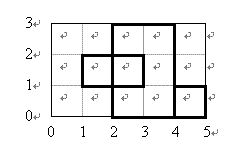当前你的浏览器版本过低,网站已在兼容模式下运行,兼容模式仅提供最小功能支持,网站样式可能显示不正常。
请尽快升级浏览器以体验网站在线编辑、在线运行等功能。
3338:Rectangle Cutting
题目描述
In the small historical village of Basinia, there is a popular activity in wedding ceremonies called rectangle cutting. During this activity, each close relative of the bride comes and cuts a rectangle in the wedding cake (but does not take a piece). The cake has a rectangular shape. The problem is to count how many pieces are in the cake after rectangle-cutting.
For example, in the following figure, the cake size is 3 × 5, and three people have made rectangular cuts in it. As a result, the cake is cut into six pieces.

Each rectangular cut is specified by the (x, y) coordinates of its two opposite corners. The input for the above figure can be found in the first sample input. As there are large families in Basinia, the number of pieces may be large and we need a computer program to compute it.
输入解释
The input contains several test cases. Each test has several lines. The first line has two integers w (1 ≤ w ≤ 20) and h (1 ≤ h ≤ 20) which are the width and height of the cake. The second line contains a single integer n (0 ≤ n ≤ 50) which is the number of people who cut rectangles in the cake. After this, there are n lines each containing the integers x1, y1, x2, y2 which are the coordinates of two opposite corners of the cut. You may assume 0 ≤ x1, x2 ≤ w and 0 ≤ y1, y2 ≤ h. The last line of the input is a line containing two zeros.
输出解释
For each test case, write the number of pieces the cake is cut into.
输入样例
3 5 3 1 1 3 2 4 0 2 3 4 0 5 1 6 6 2 2 0 5 3 3 1 4 2 0 0
输出样例
6 3
最后修改于 2020-10-29T06:59:10+00:00 由爬虫自动更新
共提交 0 次
通过率 --%
| 时间上限 | 内存上限 |
| 2000 | 65536 |